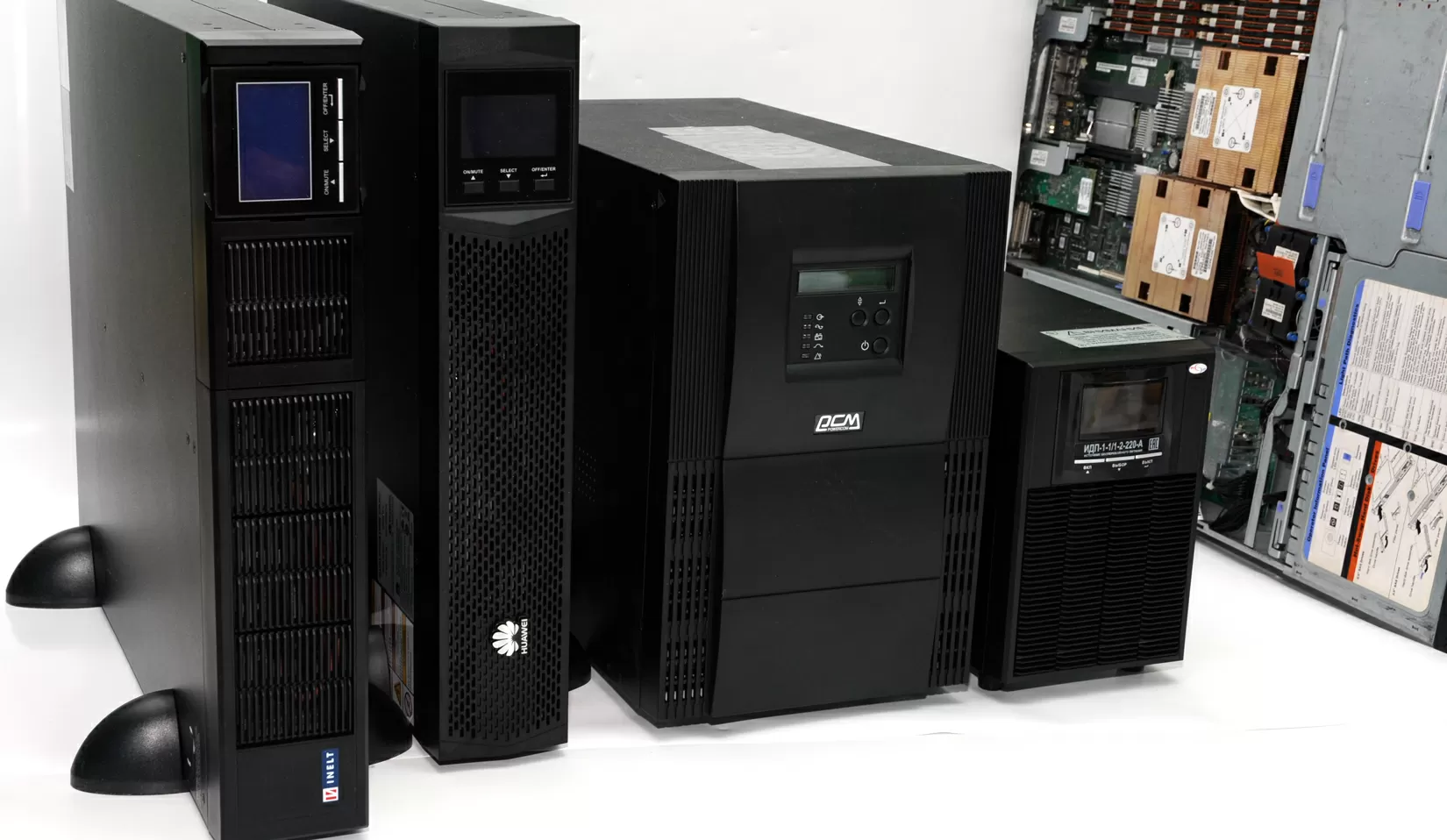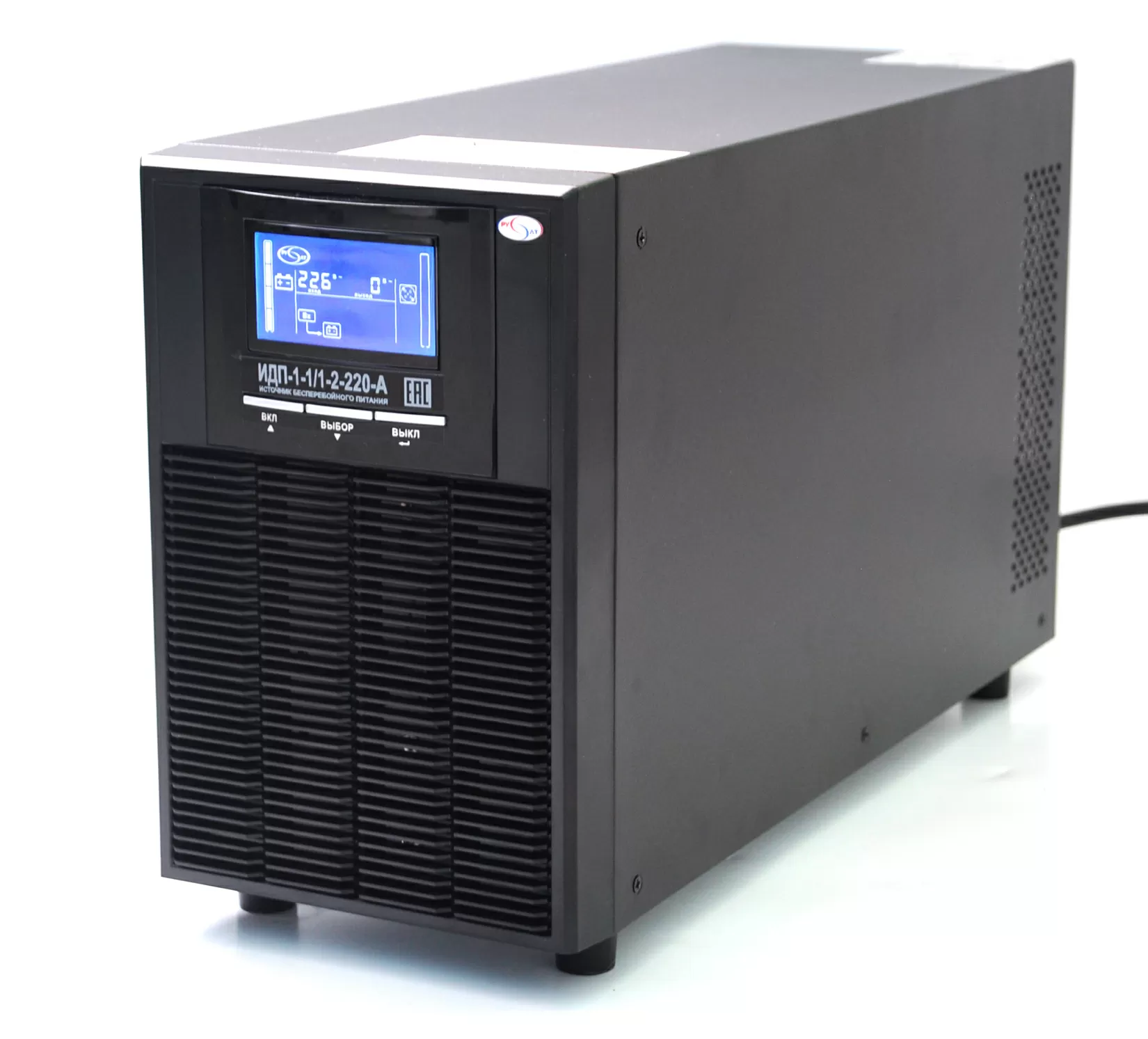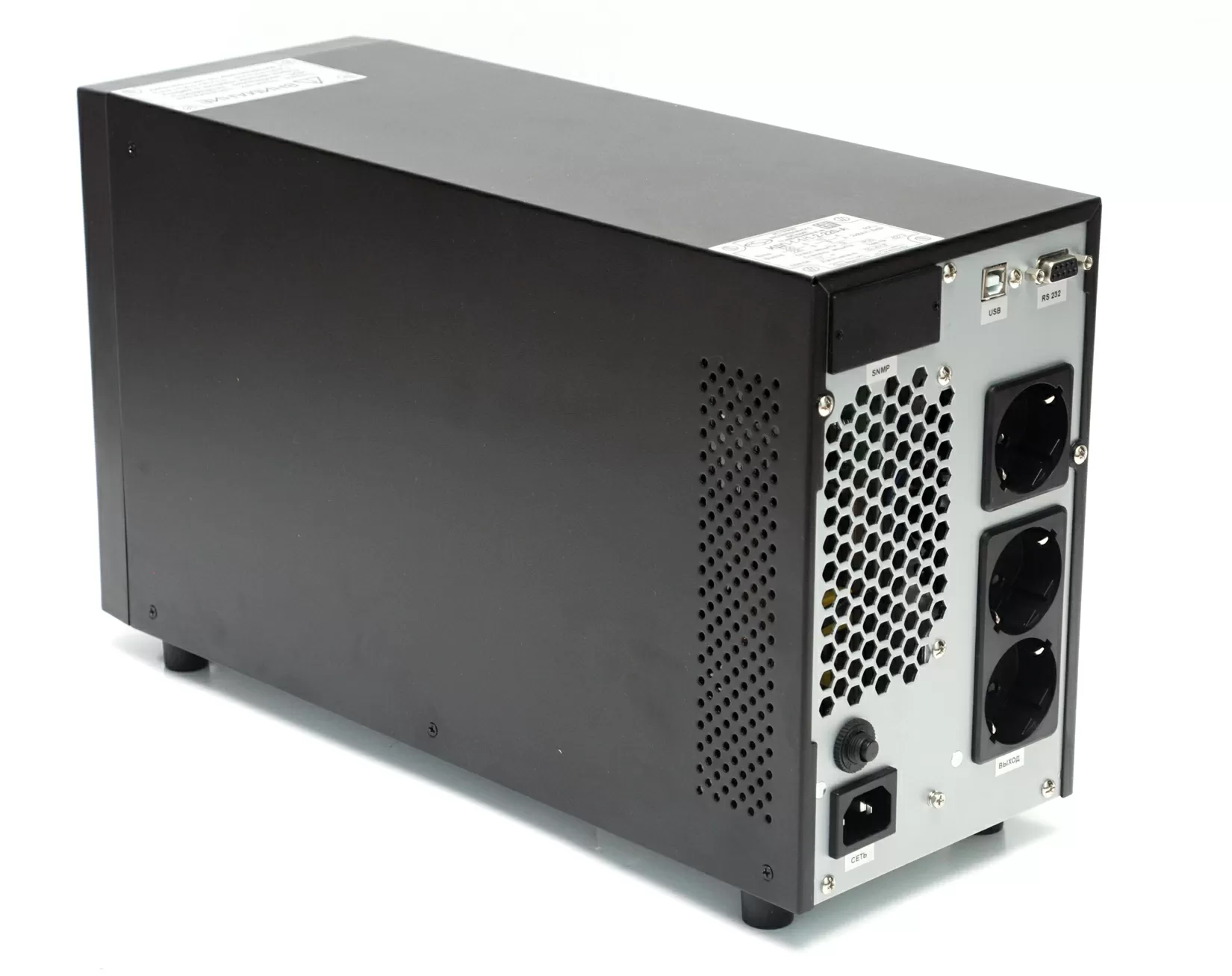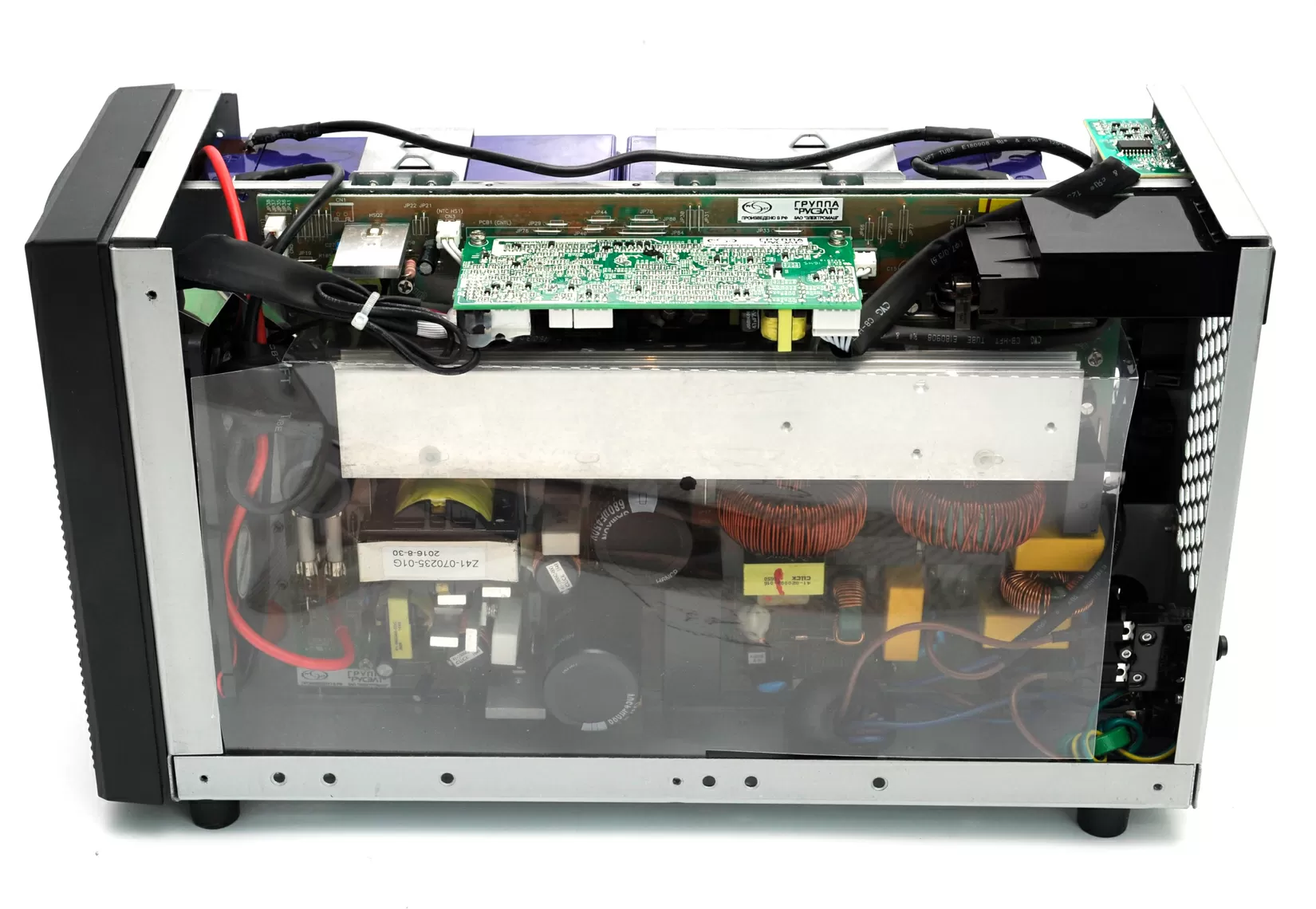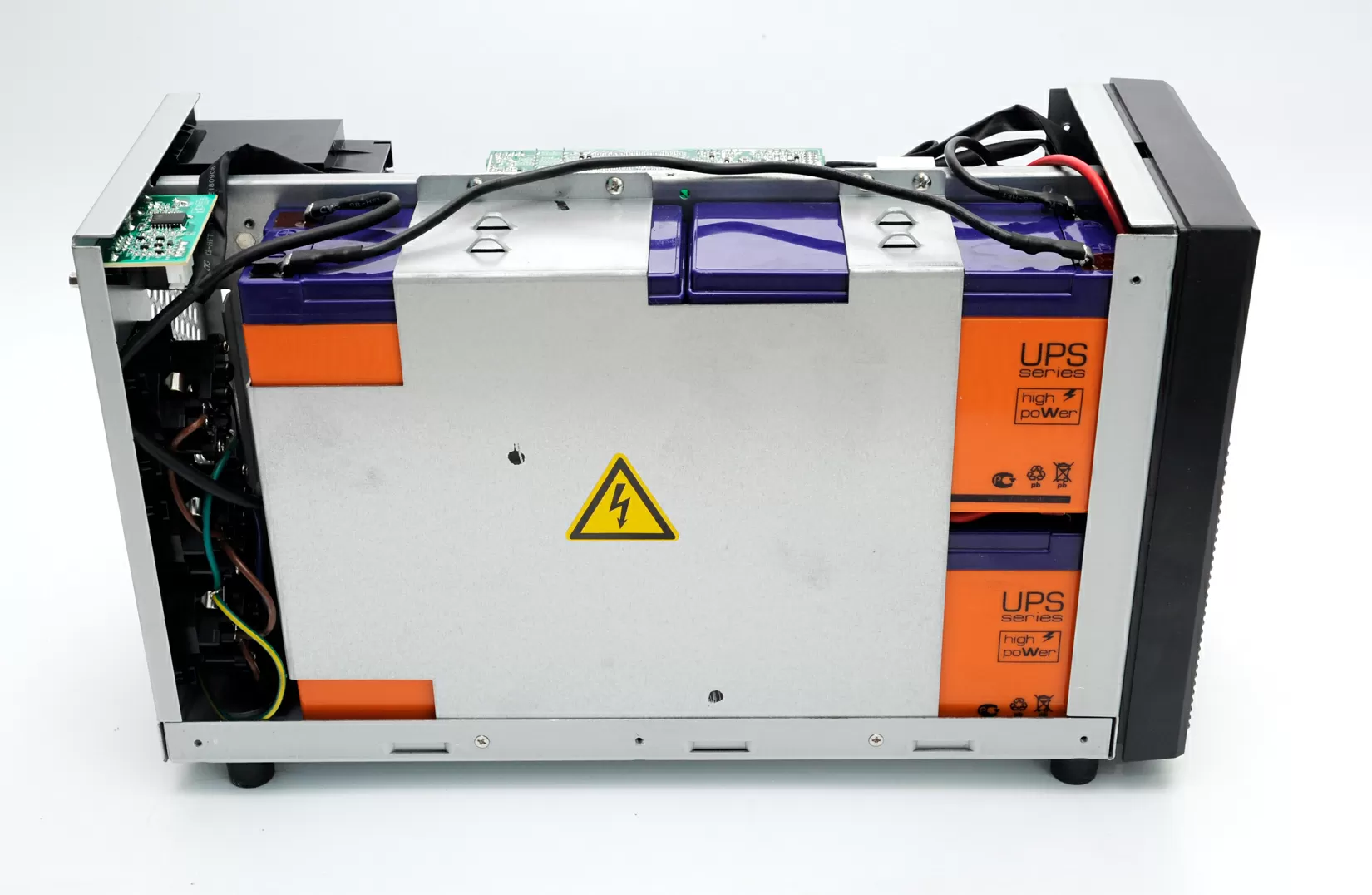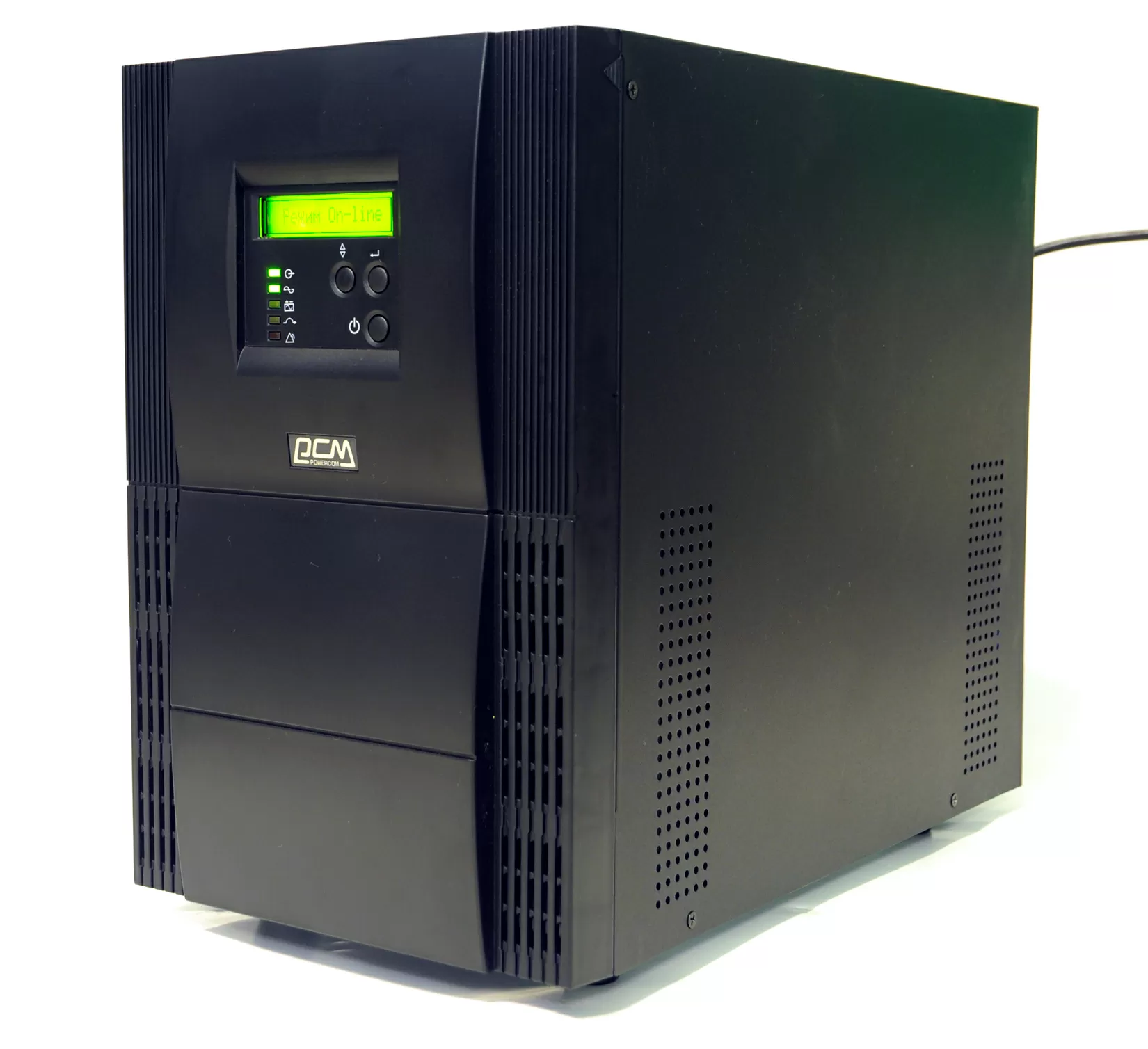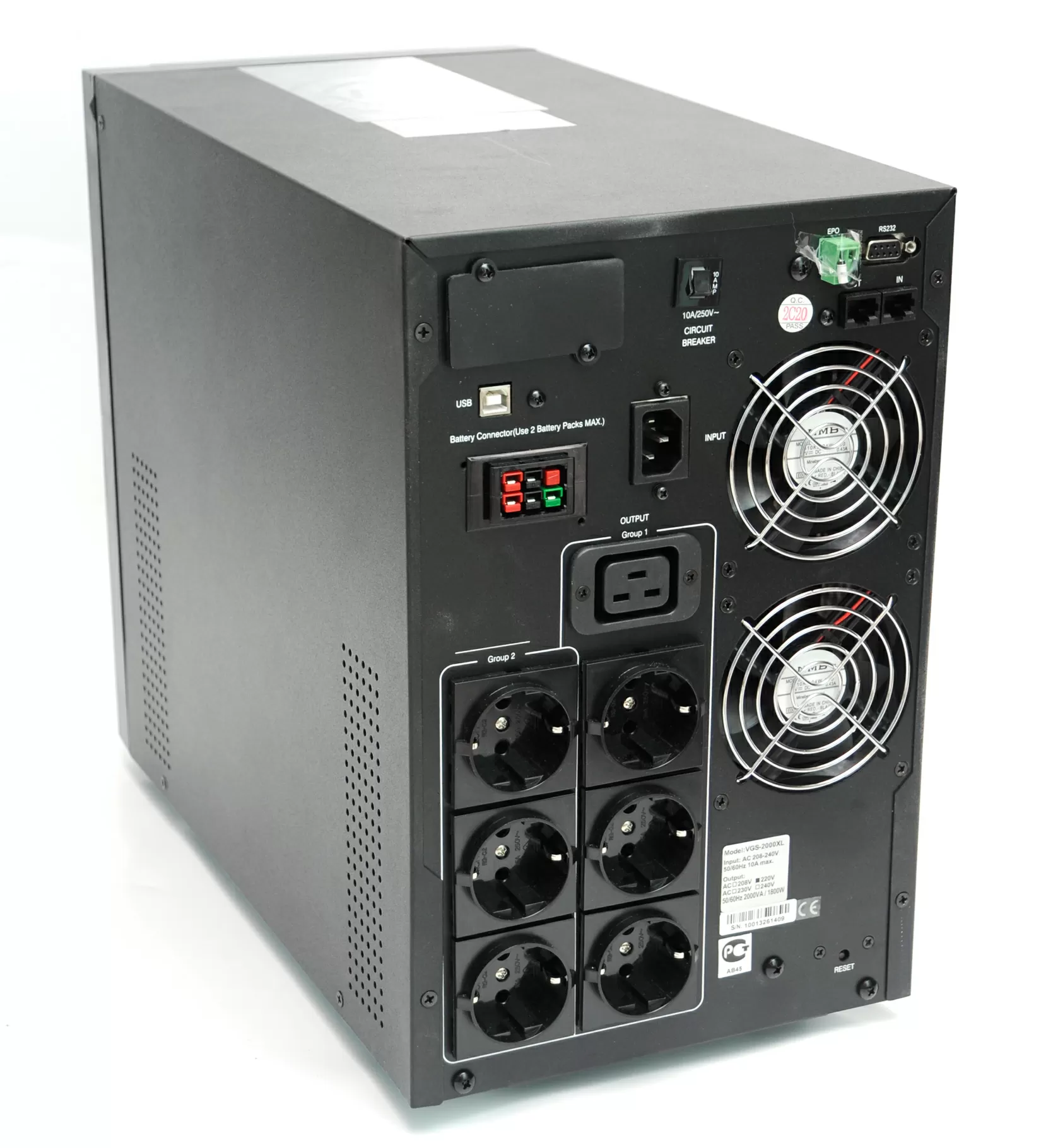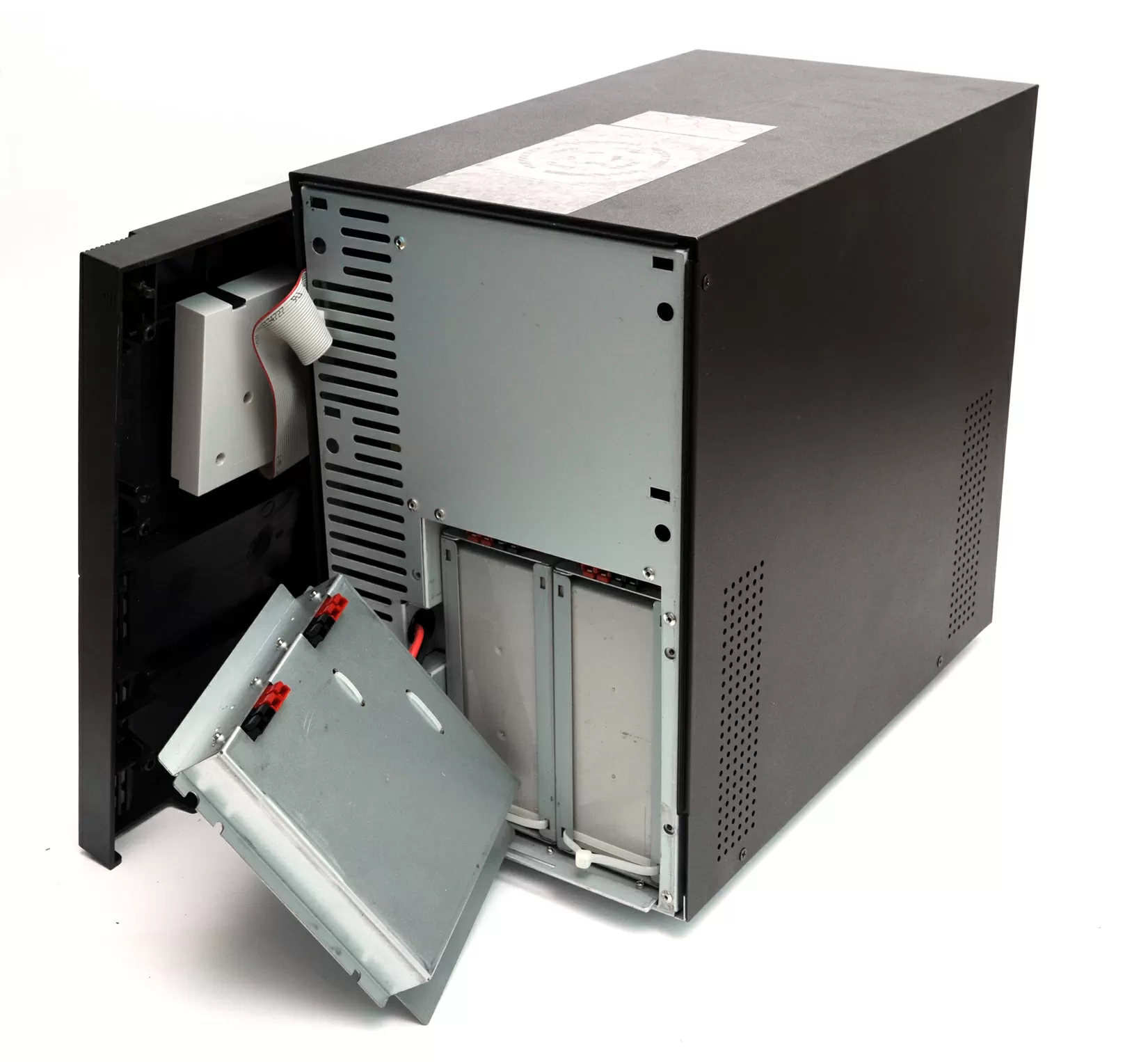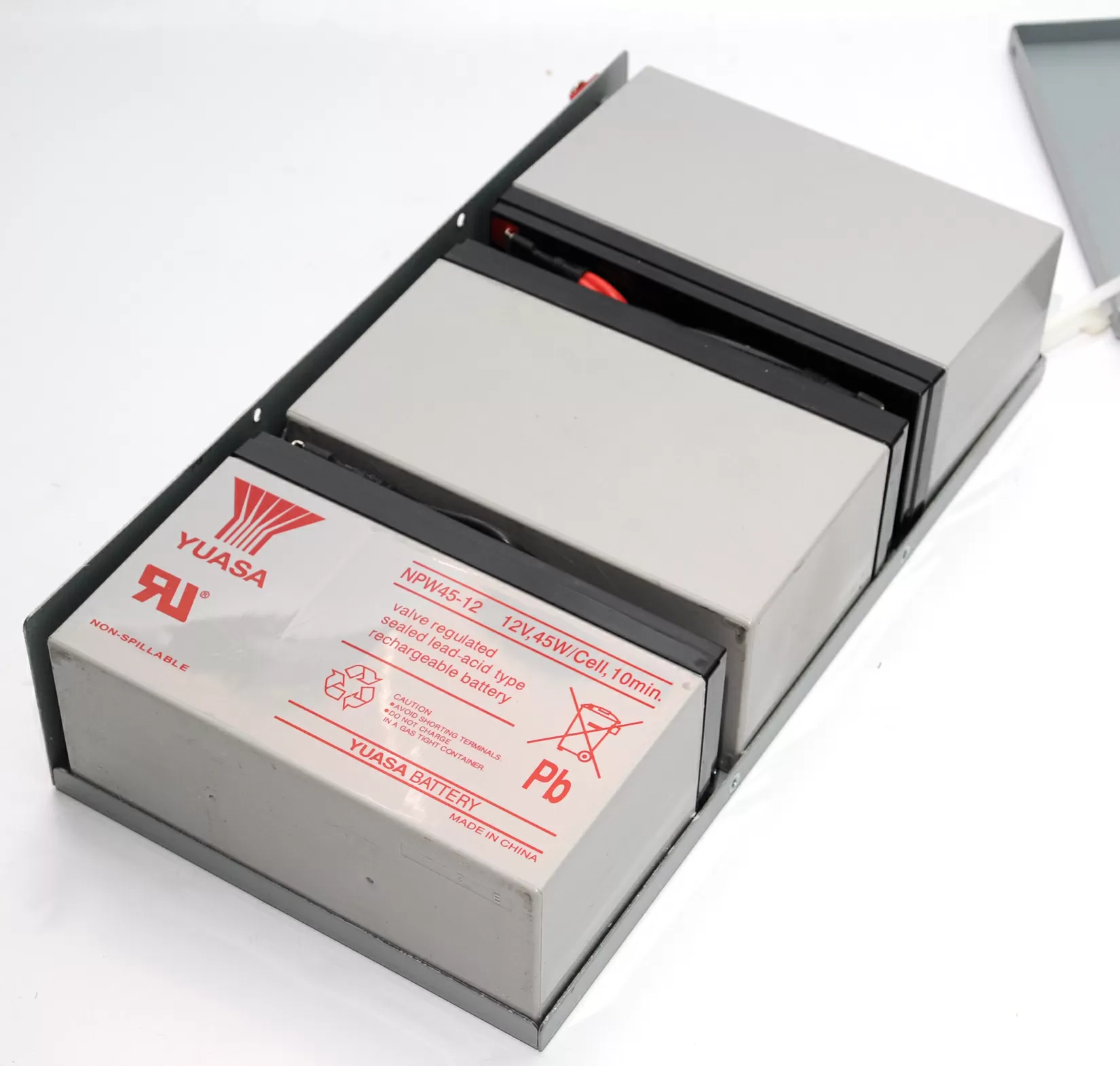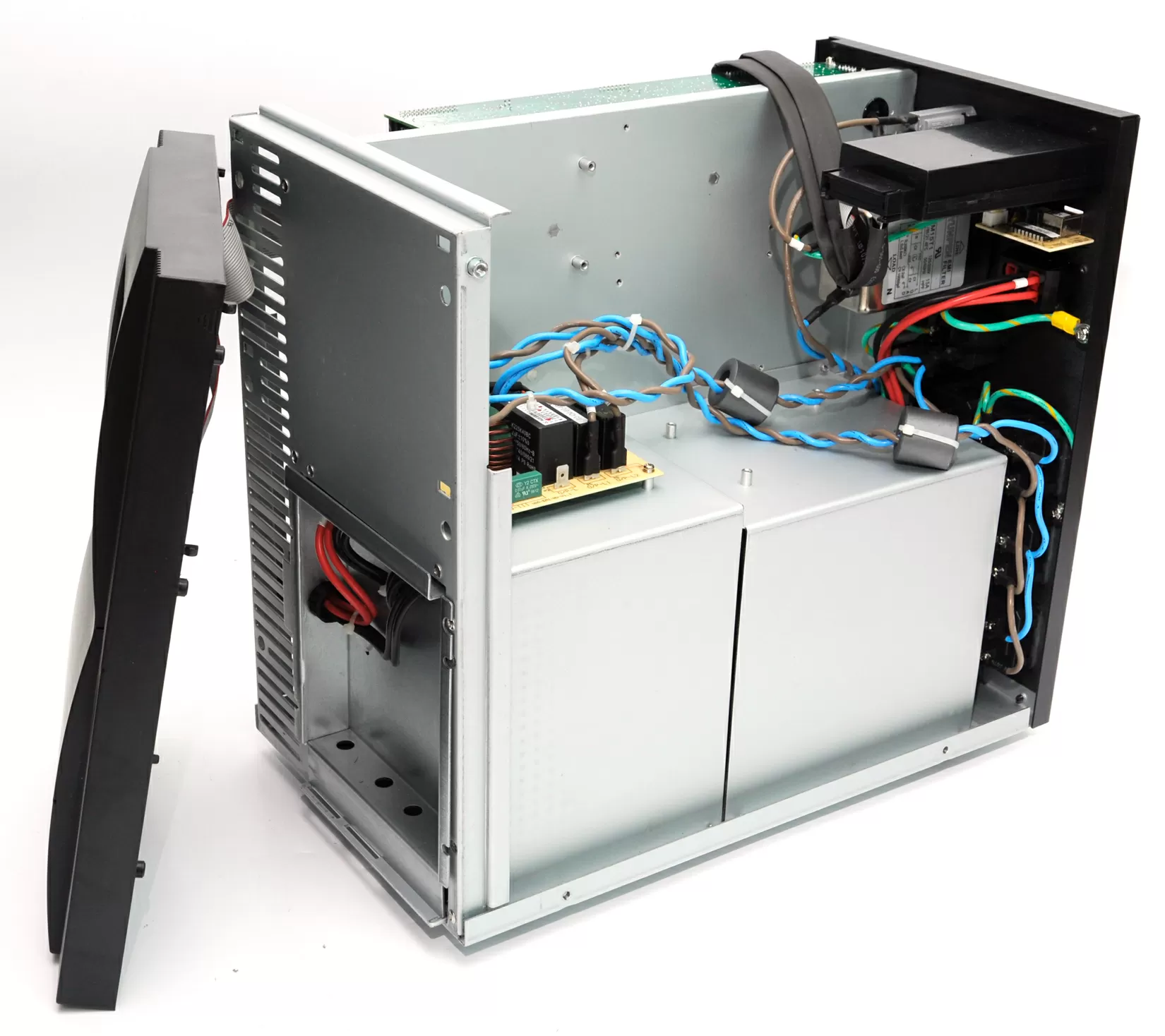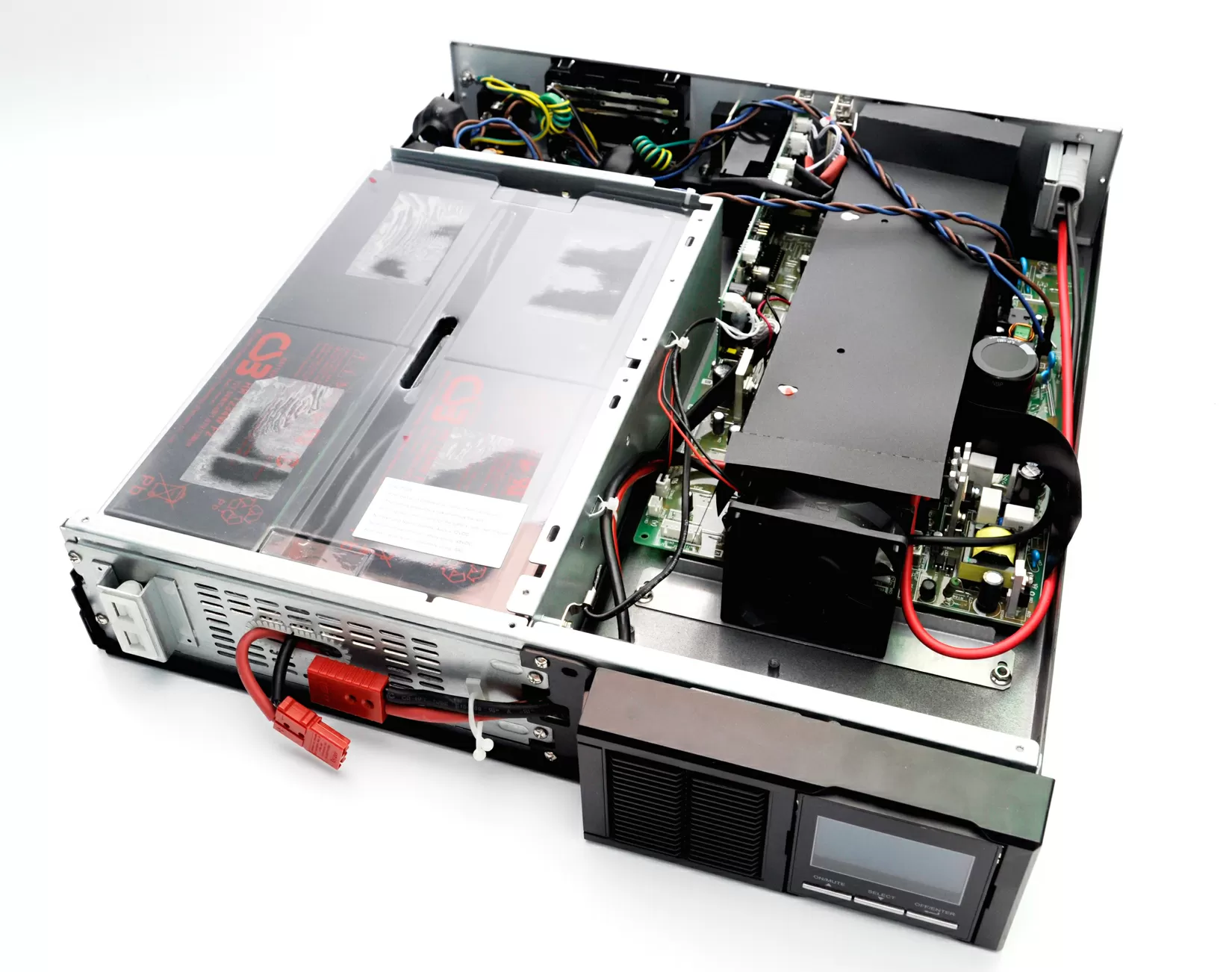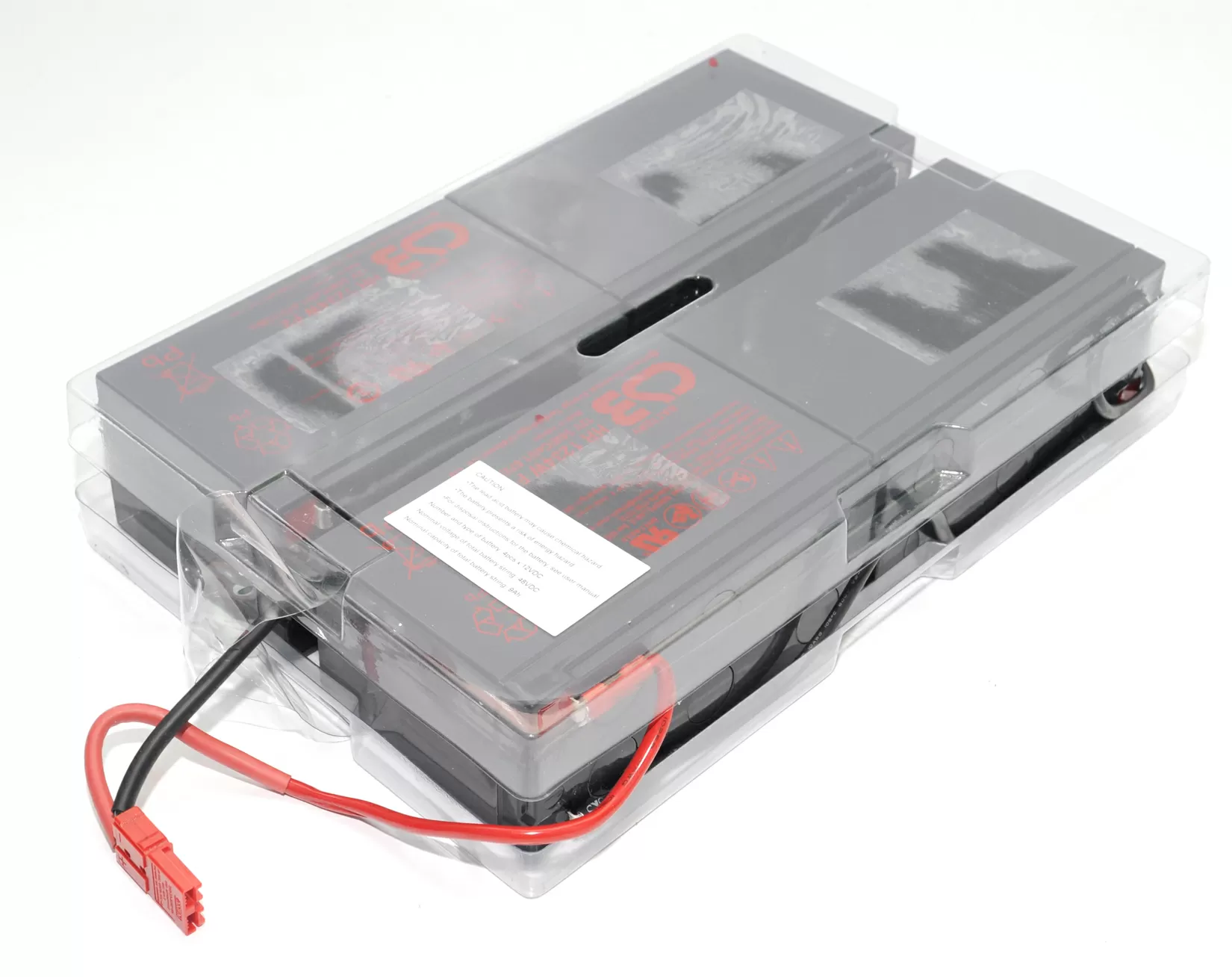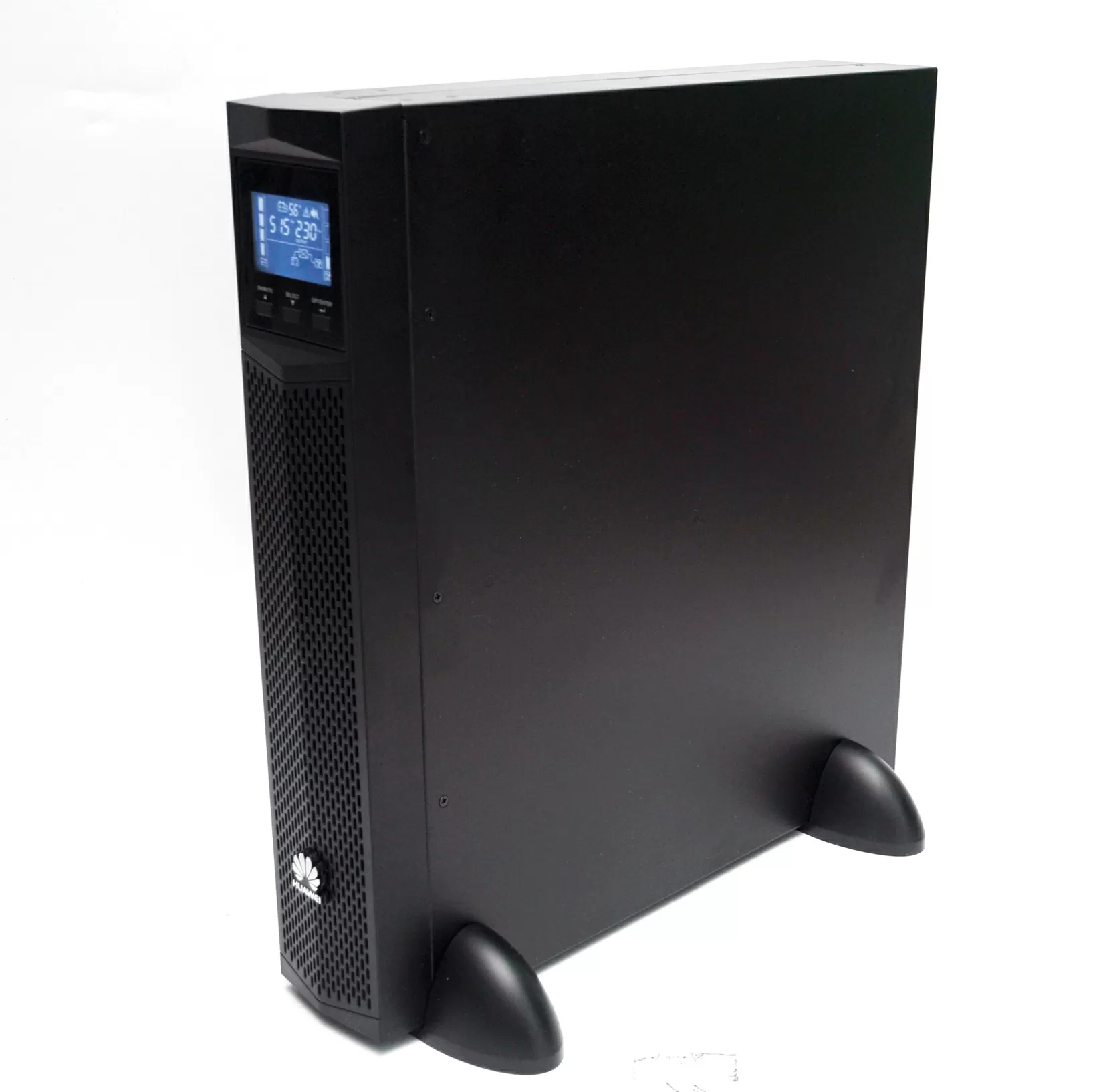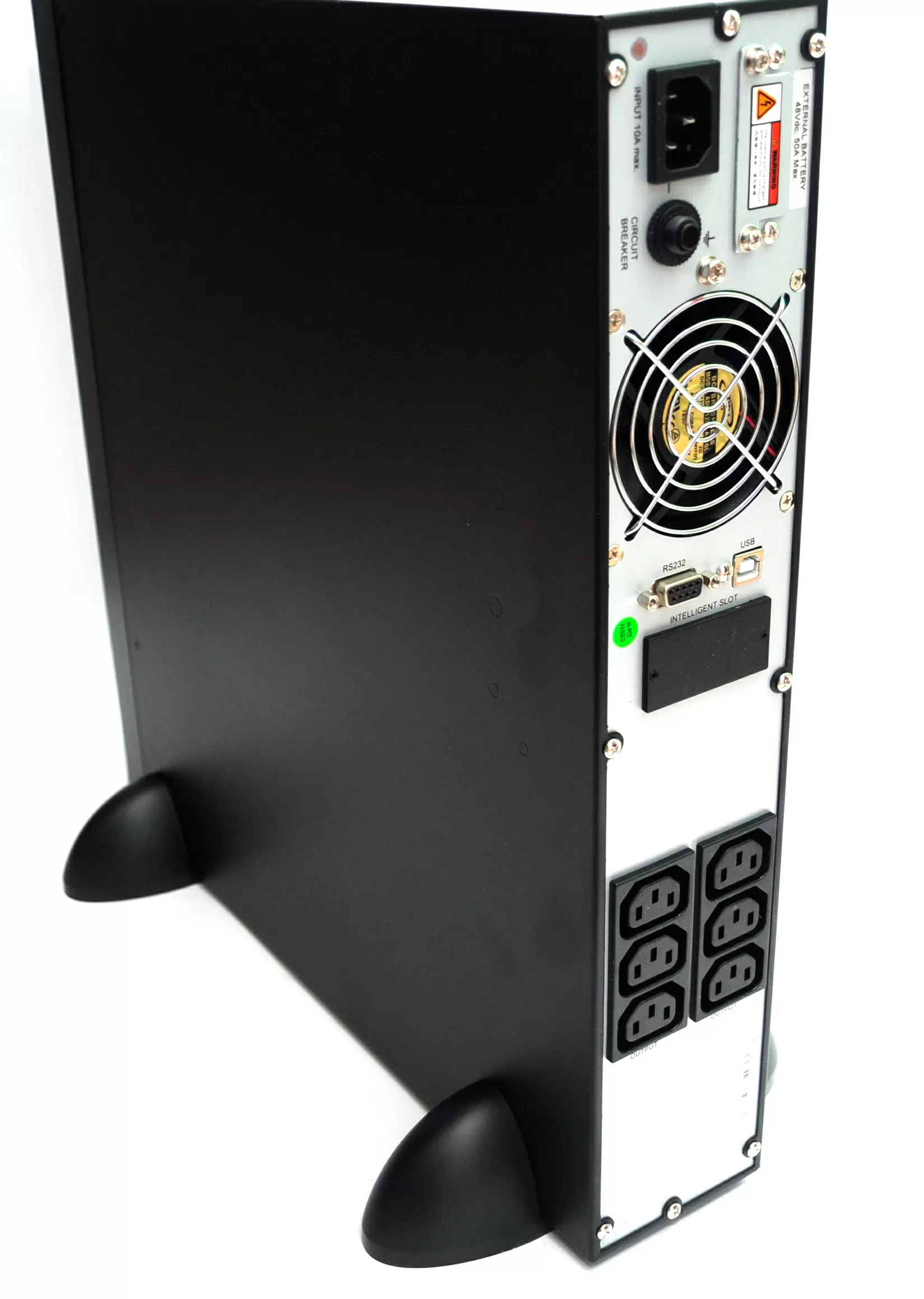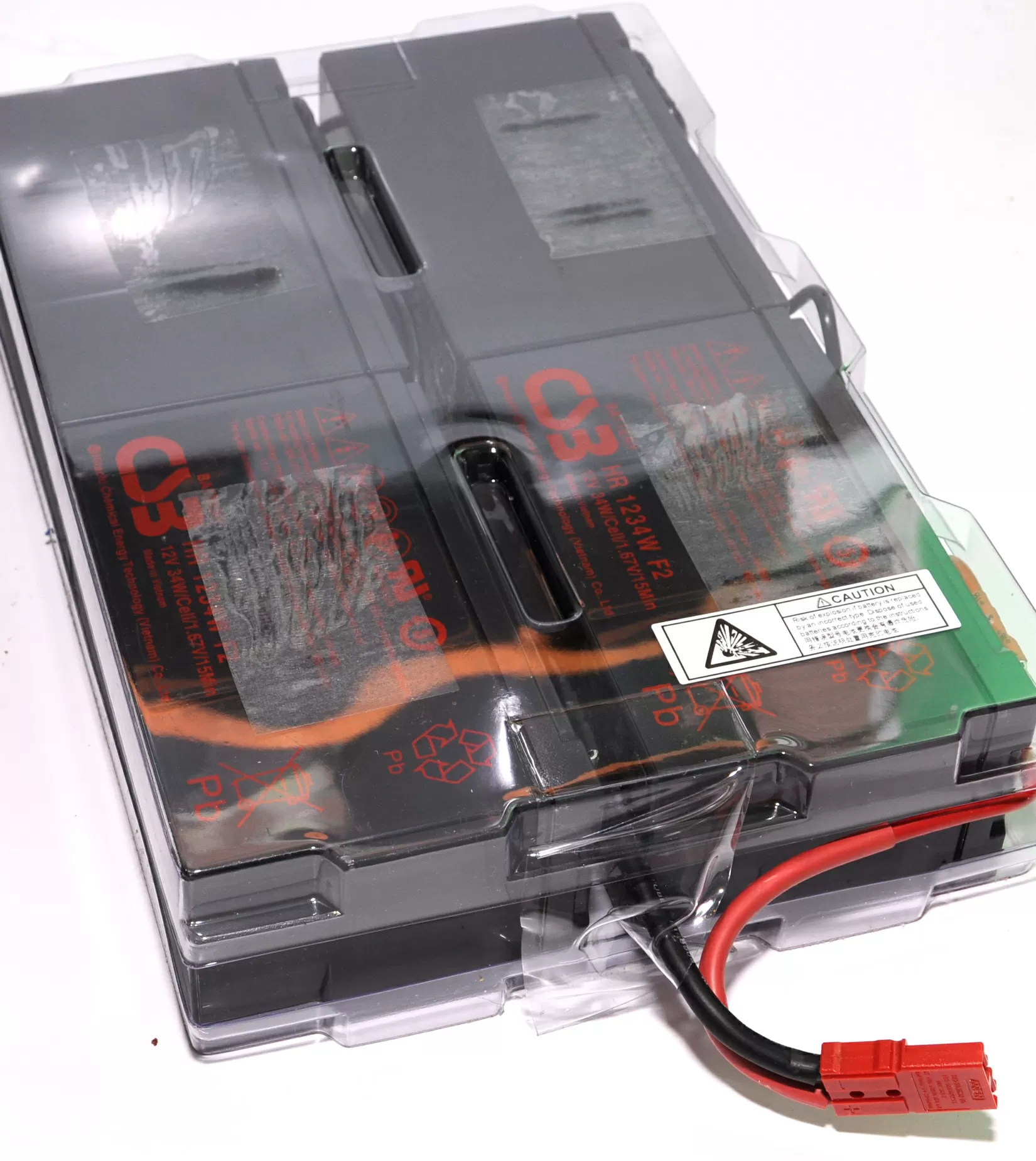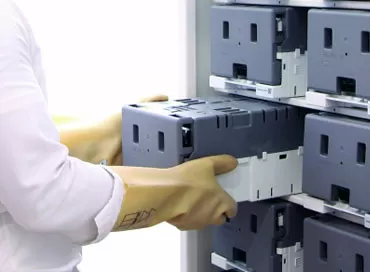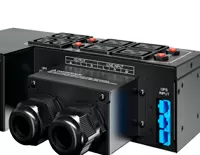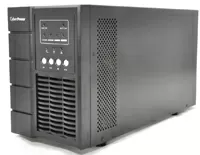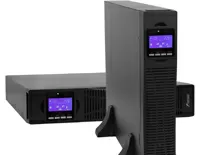Comparison of four 2 KVA online UPSes from PCM, RusElt, Inelt and Huawei
Double conversion uninterruptible power supplies, or, as they are more often called, On-Line models, are most often used to protect expensive telecommunications, medical and server equipment, when the total load power already requires the installation of an UPS of several thousand VoltAmpere, and there is no point in trying to save money by installing cheaper line-interactive models. In double conversion models, the AC current from the outlet is first converted to DC, and then back to AC, but with the reference parameters of voltage, frequency, shape and purity of the sine wave. This provides the maximum level of equipment protection against any electrical anomalies, including harmonic distortion and power noise.
In most cases, the dual power conversion circuit is redundant for use in business centers and residential premises: modern household appliances and professional electronics no longer have such a negative impact on voltage parameters as 10-15 years ago, and the power supplies of servers, network gateways and storage systems calmly survive voltage fluctuations, small frequency jumps, and any interference. However, the cost of the above equipment is so high that when thinking about a UPS, a typical customer simply chooses the most advanced type of power protection, which today only provides double conversion.
A floor-standing UPS is most often used where there is no space in a server cabinet, or it hangs on the wall, and it is undesirable to load it with excess weight, plus to protect stand-alone devices such as powerful computers for working with graphics, diagnostic equipment, medical security equipment and systems.
What features to look out for when choosing a double conversion UPS in 2018?
In addition to technical parameters such as battery life, output sinusoidal shapes and others, which can only be checked during testing, there are also those that you should pay attention to at the selection stage. These features can significantly reduce operating costs as well as improve equipment battery life during power outages.
- Load segmentation, or grouping of equipment by outlets . The UPS can functionally shut off some of its outlets when it goes into battery mode, so as not to waste precious power on something you can do without. For example, if the office turns off the electricity, then the office switch is not needed - everyone's computers do not work anyway, but the video surveillance system or the main server is more important. At the UPS software level, sockets are formed into groups and parameters are selected when to turn off the first group of unnecessary consumers and when to turn it on in case of power supply resumption.
- High Efficiency On-Line UPS . It was originally created for those who pay for electricity by the meter, and do not take a quota for production. In this mode, the UPS turns off double conversion and operates like a line-interactive. Due to the design features of double conversion UPS, high efficiency can be either completely absent or be on the level of the most expensive traditional line-interactive models. Honestly, I do not quite understand what this is for in practice - double conversion guarantees high purity of power at the output, and if you have such a UPS, use it for its intended purpose.
- Connecting Emergency Power Off (EPO) Systems . If it happens that a fire has occurred inside the equipment cabinet, the first thing to do is turn off the power. In serious organizations with high security requirements, there are emergency shutdown buttons that not only cut off power to the entire office, but also turn off all UPSs in one go, instantly, without delay. Expensive UPSs have a special input for connecting the `` big red button ''
- Connecting external batteries . Today on sale you will find two types of UPS with the ability to connect external batteries: the first is the traditional scheme, when the UPS itself has built-in batteries, and separately you can purchase a block with batteries from the same manufacturer, so that both are covered by the warranty, the second type - this is a UPS without built-in batteries, designed for external, usually specialized or even automobile. In the first case, you save at the stage of purchasing UPS and expand the capacity as needed, and in the second case you can immediately install large-capacity batteries, for example, for radio transmission equipment.
And, of course, software - all modern UPSs, as a rule, are supported by built-in monitoring tools for Windows and Linux operating systems, but support for Vmware vSphere is a serious argument for companies using this hypervisor for virtualization.
What is important from the technical specifications?
- Different type of sockets. Floor standing UPSs are available with both Euro and IEC-320 sockets, and universal, supporting rack mounting - mainly have computer sockets of the IEC-320 type.
- High battery life
- The effectiveness of the "eco-mode", if any.
- High level of efficiency
- Perfect sine wave at the output
- Switching to batteries as late as possible when the mains voltage drops and returning to double conversion when the mains voltage rises above the shutdown threshold - this saves battery power in such a rare accident as undervoltage.
So, having defined the modern requirements for double conversion UPS, we can move on to our test subjects.
RUSELT ISTOK IDP-1-1/1-2-220-A
ISTOK uninterruptible power supplies are manufactured by the Russian company RUSELT at the plant of JSC "Electromash" in the Tula region. In addition to UPS, the manufacturer offers a wide range of electrical equipment: voltage stabilizers, frequency converters, power transformers, electric motors. We have never tested Russian UPSs before, and I am very interested in how the build quality of this product is comparable to what we see in models from other manufacturers.
The first thing we pay attention to is the size of the uninterruptible power supply. It is generally accepted that models with double conversion are large and heavy devices, but ISTOK IDP-1 is comparable in size to linear-interactive models for 1000 VA.
What do you have to pay for such compactness? First of all, the number of outlets: there are only three of them, all of them provide backup power according to the double conversion scheme, but there is no grouping by consumers here.
The second point is the replacement of storage batteries, which is performed only in service centers. Technically, there is nothing complicated in this process - you remove the cover and change the batteries, but for this you have to stop the operation of the connected equipment. But I would like to note that in the Online UPS line of RUSELT there are models for rack installation, with hot-swappable batteries and connection of additional battery modules.
Having disassembled the SOURCE IDP-1, we see that 4 batteries DELTA HR 12-34W with a capacity of 9 Ah each are used here. These are VRLA AGM lead acid batteries with a stated service life of up to 8 years.
You can adjust the charging current in the range from 1 to 6 Amperes to reduce the load on the electrical network after a power outage, if you have a large fleet of equipment and use a lot of UPS.
Concerns about the components of the domestic UPS are groundless: all the element base is made on imported components.
To display information about the operation status of the IDP-1 series UPS, a control panel with a convenient and simple interface is located on the front panel. Looking ahead, I will say that a similar one is used on two other UPSs in our review.
In addition to the current operation diagram (mains or battery mode, Eco mode, bypass), the screen displays input and output voltages and frequencies, information on the battery charge level and autonomy time, and error indication, in case of equipment malfunction. All of this information is displayed at the same time, so one glance is enough to get an idea of the current operation of the device and the connected load. To use the control panel, you will definitely have to take the instructions in hand and see what each menu item means.

In general, structurally, the ISTOK IDP-1 shows that a double conversion UPS is not always a huge box with a bunch of sockets, which, when opened, turns out to be half empty; it can be a compact solution with an informative screen and ergonomic management. If silent, it could be recommended for use in a room where staff work, but double conversion schemes require constant air circulation and powerful fans are inevitable.
PCM Vanguard VGS-2000XL
PCM () - one of the oldest manufacturers of UPS and power conditioners on the Russian market, and if you look at the design of the Vanguard series, you get the impression that these devices have always been here and have never been updated, although this is not at all the case. In part, such a deceptive impression arises from the very large dimensions of the UPS: we are used to the fact that now every device is made thinner and lighter, but here PCM goes against the trend, and the question arises - why?
First of all, the Vanguard VGS-2000XL has 6 Euro sockets, pided into 2 groups for independent shutdown in stand-alone mode, the so-called segmentation. In addition, this UPS has 1 IEC320 C19 receptacle, which is typically used in devices such as Blade servers or matrix switches or PDUs for such devices, in general, where currents from 10 to 15 Amperes are required, and the power of the connected loads is from 2.3 to 3.3 kW, which is significantly more than the rating of the UPS itself.
And here you need to be careful and remember the basics of security. The fact is that IEC320 C19 sockets are specifically incompatible with conventional IEC320 C13, which are found in power supplies for computers and servers, so that the user foolishly does not plug a 3-kilowatt plug into a regular outlet and cause an overload, which, at best, will knock out the machine or UPS protection will trip, and in the worst case, the wiring will light up. The PCM input of the VGS-2000XL has an electromagnetic 10-amp overload circuit breaker, and why a 15-amp outlet is here, we can only guess.
The PCM Vanguard VGS-2000XL has an EPO connector for emergency shutdown, which allows it to be used in conjunction with a centralized fire alarm.
To extend the battery life, you can connect up to two additional PCM BAT VGD-72V battery packs to Vanguard VGS-2000XL, each containing 12 7.2 Ah batteries. For a typical 300 watt load, this will increase battery life from 1.1 to 8.5 hours.
The UPS itself contains 6 batteries with a capacity of 7 Ah, and the design allows hot swapping of batteries without shutting down the equipment and the UPS itself.
Yuasa NPW45-12 (VRLA, AGM) rechargeable batteries, according to the manufacturer, have a service life of up to 5 years. In the PCM Vanguard VGS-2000XL, they are housed in two bolted steel blocks.
Inside the Vanguard VGS-2000XL case is pided into two parts: on the left - the inverter, on the right - the battery compartment. In the same case, PCM produces an older 3000 VA model, where there are no longer 6, but 8 batteries, so in our case there is a lot of free space inside the UPS.

The display panel in the Vanguard VGS-2000XL is the same as that of the first generations of UPSs, when LCD screens were first installed on these devices. The status of the device is displayed by 3 LEDs with icons - it is very convenient and informative, but the whole setup and navigation through the menu is through a 1-line segment screen, like in the first cell phones. And although the entire menu is Russified, it is inconvenient to use it. Even the instruction manual says that it is better to configure the VGS-2000XL via software from a computer, and by the way PCM gives you software for any modern operating systems, including VMWare ESXi, for Android smartphones (in the form of .apk applications), for Linux and Windows.
Inelt Monolith III 2000RT
Since we are testing floor-standing UPSs, rack-mountability does not matter to us for this article - all manufacturers have rack-mount models, and almost all models up to 3 KVA have feet for them to place the UPS upright on the floor. With this setup, the uninterruptible power supply takes up very little space, but is stable and can be hidden behind a large computer case.
is a trademark under which 1-phase and 3-phase uninterruptible power supplies are sold, as well as battery modules, chargers and accessories. Monolith III is a top-end series of on-line devices from 1000 to 20,000 VA. Among the advantages, the manufacturer highlights the high efficiency of Eco-mode, as well as segmentation of electrical outlets to disconnect non-critical equipment and connect external battery modules.
Inelt Monolith III 2000RT has 8 IEC320-C13 sockets, pided into 2 groups, the UPS itself is connected to the network via a 15-amp IEC320-C19 socket using a mains cable with a regular Euro plug. On the back of the case there is an EPO connector for emergency power off, a slot for an SNMP card, a connector for an external battery module and ports for connecting to a computer.
Inelt Monolith III 2000RT allows you to connect up to two BFR-48-18M battery modules, each of which has 8 batteries with a capacity of 9 Ah.
The source itself has 4 CSB HR1234W F2 (VRLA, AGM) batteries with a capacity of 9 Ah, which can be replaced with a "hot" one, that is, without turning off the UPS or consumers, beforehand activating bypass mode. The battery manufacturer claims a battery life of up to 5 years.
The control panel is very similar to what we saw at ISTOK IDP-1/1-2-220-A. In general, these two sources have a lot in common: similar control, similar indication, even the ventilation grilles on the front panel seem to be stamped with one stencil.
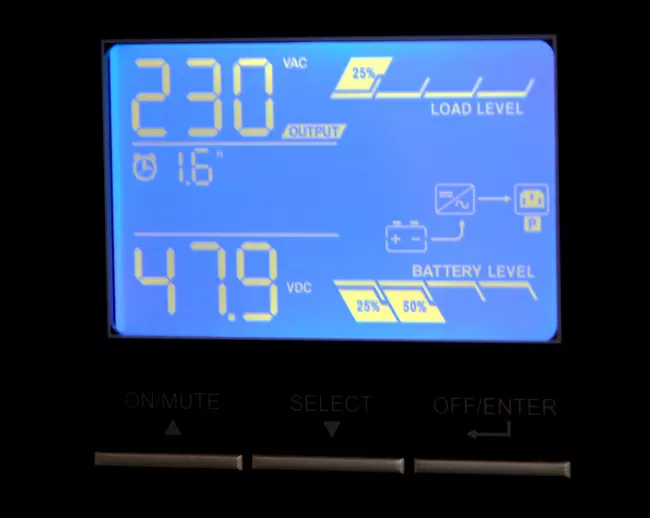
Here, the screen also shows the diagram of the power supply through the UPS, the level of loading and charging the batteries, whether the eco-mode is enabled and whether the bypass is enabled. To configure the UPS through the control panel, you will have to pick up the instructions and see which menu item (they go only under the numbers), and of course it is better to use the software from the manufacturer's website: all modern versions of Windows, MacOS, two dozen Linux distributions are supported, Solaris and VMWare ESXi.
Huawei UPS2000-G-2KRTS
Huwaei consortium produces a full range of equipment for data centers and enterprises, including servers, storage systems, telecommunication equipment and communication facilities. Uninterruptible power supplies are one of the giant's activities. They are not common on the market, but customers looking for a mono-brand infrastructure and using other Huawei products can choose a UPS from the same manufacturer to create a mono-brand infrastructure. But UPS for Huawei is not a by-product, but a whole direction, and on the company's website you can find solutions with a capacity of up to 800 KVA.
The UPS2000-G model we are considering, like the Inelt Monolith III, is produced in a universal case that allows you to mount the device in a rack and put it on legs in a vertical position. Interestingly, the large Huawei logo on the front of the case can be rotated horizontally or vertically. The control panel for installing the UPS in a vertical position is just as easy, with one movement of the hand.
Huawei UPS2000-G-2KRTS has 6 IEC-320 sockets, connected in parallel, without segmentation. In general, if you look at the case from the back side, then it is somehow empty: a slot for connecting an SNMP card, an input for an external battery module, RS232, USB, and actually that's all: there is no EPO, no LAN cable protection.
To increase the battery life, one Huawei ESS-48V12-9 * 2AHBPVBB01 battery pack can be used, containing 8 batteries of 9 Ah each.
The UPS has the same battery pack as the Inelt Monolith III 2000XL, 4 CSB HR1234W F2 (VRLA, AGM) batteries, 9 Ah each, are packed in the same way. "Hot swap" is supported through manual transfer to bypass mode, although the instructions do not say anything at all about how to change batteries, other than "contact the professionals."
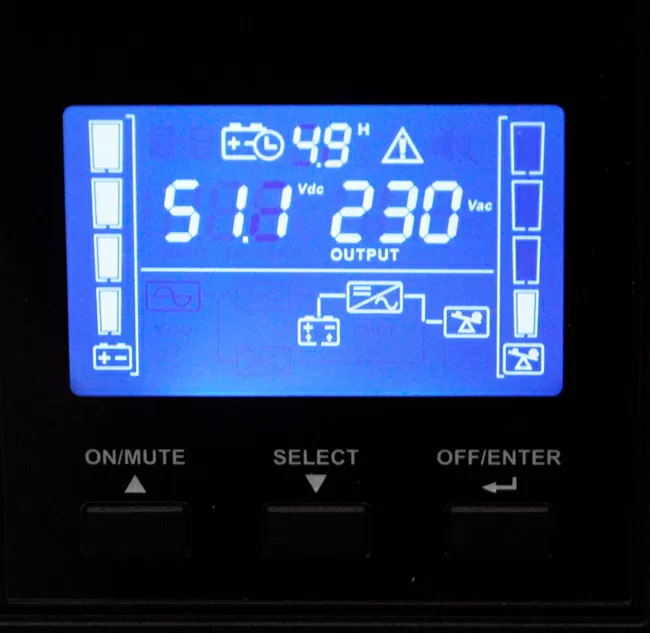
The control panel has a lot in common with both RUSELT IDP-1-1/1-2-220-A and Inelt Monolith III, but still a little different in design, and again, only English language. But almost all functions, including the parameters of the SNMP card, can be set through it without installing the software, you just need to take the instructions.
In general, according to the design, Huawei UPS2000-G-2KRTS stands out only for the quality of the front panel and LCD screen, and there are no distinctive features in the circuitry. In our testing, this is the most affordable option, and how it will show itself in practice, we will now check.
Comparison table of tested UPS
Let's summarize the main differences between the tested UPS in a general table.
|
Source IDP-1-1/1-2-220A |
PCM Vanguard VGS-2000XL |
Inelt Monolith III 2000 |
Huawei UPS2000-G-2KRTS | |
| Number of sockets | 3 | 6 + 1 | 8 | 6 |
| Load segmentation | No | Yes | Yes | No |
| EPO input | No | Yes | Yes | No |
| Connecting the battery pack | No | Yes | Yes | |
| Built-in batteries | 4x9Ah | 6x7Ah | 4x9Ah | 4x9Ah |
| Hot swap batteries | None | Yes | Yes | Yes |
| SNMP card | Yes | Yes | Yes | Yes |
| LAN protection | Yes | Yes | Yes | No |
Well, let's start testing.
Testing
We started the testing process by removing the signal at the UPS output. All four subjects showed an ideal sinusoid and frequency, as you can see in the diagram below.

That is, no matter how demanding the consumer of electricity is, when connected to any of the tested UPSs, it will receive a reference voltage that exceeds in characteristics (amplitude, frequency, sinusoidal quality) supplied from the outlet.
Let's move on to the second significant research for us - the efficiency of our own energy consumption. Here I would like to point out that the Inelt Monolith III 2000 RT was the only UPS that provided two saving modes: simple high efficiency mode and advanced, which was chosen by us for efficiency testing.
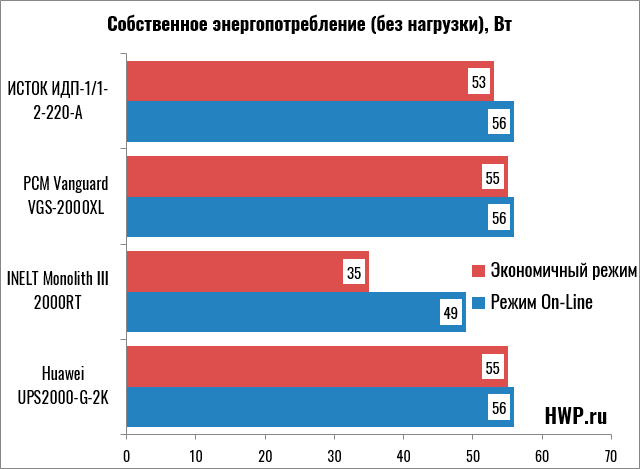 Own power consumption without load (Wt)
Own power consumption without load (Wt)
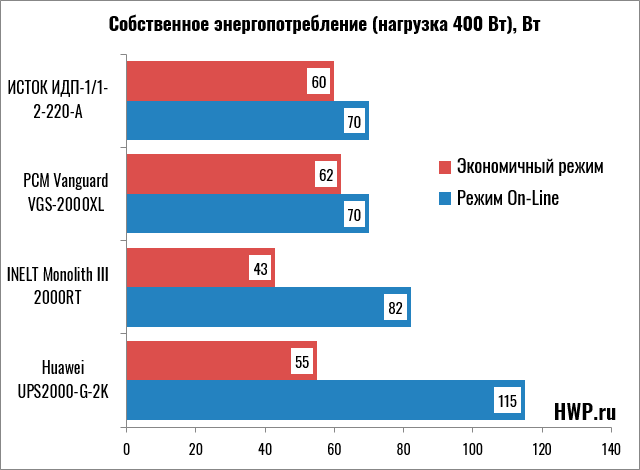 Own power consumption under load 400 VA, Wt
Own power consumption under load 400 VA, Wt
In general, it's hard for me to say why an On-Line UPS is needed in the mode when voltage is supplied bypassing double conversion to save energy. Well, unless you can not buy a line-interactive UPS of the capacity you need, and you are very worried about the electricity bills. Inelt Monolith III 2000RT performs best in this test.
The next test is the voltage at which the UPS goes to battery power and back. We gradually lowered the input voltage with a 400W load connected to detect when the standby mode was triggered, and then gradually raised the voltage to see when the UPS would return to double conversion. By the way, when running idle, we got the same results.
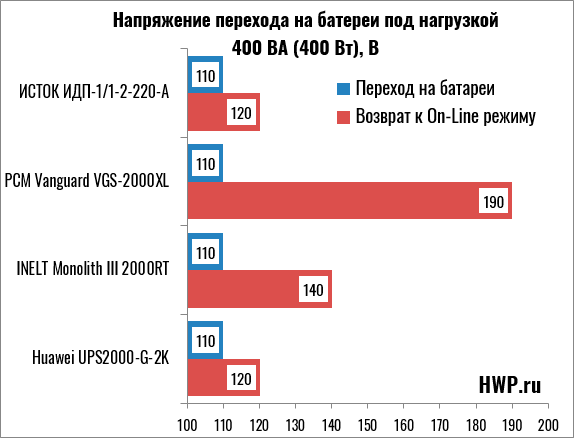 Battery transfer voltage, under load, Wt
Battery transfer voltage, under load, Wt
In general, going offline at half the nominal voltage is the norm for all four, but PCM Vanguard VGS-2000XL returns to On-Line mode too late. What does this mean in practice - the voltage dropped by 105 Volts - all the UPSs turned on to power from the batteries, went up by 150 Volts - Source IDP-1, Inelt Monolith III 2000RT and Huawei UPS2000-G-2KRTS turned on back to mains power, and PCM The VGS-2000XL continues to drain battery power. If the voltage simply dropped from 230 to 150 Volts, all UPSs will operate on mains using double conversion.
In general, the situation when the voltage drops by half and then returns to the level of 140-150 Volts is very rare. Let's just say that it is not found in business centers and industrial enterprises, but in rural and suburban distribution networks, where the voltage is often low, such an accident can occur.
Switch on cold: 1600 W . All four UPSs survived fully off, without utility power, when connected to a 1670 VA (1600 W) resistive load.
Load and server testing
The main test is battery life, and we used three tests: a synthetic resistive load of 400 W, a synthetic load of 1600 W (1670 VA), which is 90% of the nominal power of the UPS, and a real-world load: two IBM X3550 servers , on which 8 virtual machines were running during the test, and as in real life, the power consumption of the servers constantly floated from 480 to 520 W, but good power supplies provided a power factor of 0.98-0.99, that is, the server load is almost completely active in nature.
 Battery life (Minutes:seconds)
Battery life (Minutes:seconds)
Interestingly, Istok, Monolith III and Huawei UPS2000 use batteries of the same capacity, but show completely different results. In the end, the one with the larger battery is right, and this is the PCM VGS-2000XL.
Conclusions
Based on the results of comparison and testing, PCM Vanguard VGS-2000XL is declared the winner.

This is the optimal model for use in business centers or in your own small data centers, but for summer cottages and villages where the voltage is often reduced, it is better to choose something else.
Inelt Monolith III 2000XL - all parameters are perfect, and if this UPS was cheaper, it would be a winner.
RUSELT ISTOK-1-1/1-2-220-A - power parameters at the output of ISTOK are the same as those of Monolith III, the control panel is in Russian, in terms of investment efficiency it is only slightly behind the leader.
Huawei UPS2000-G-2KRTS is the most affordable option from the tested four, plus the ability to connect an external battery pack.
Mikhail Degtyarev (aka LIKE OFF)
03/11/2018

